Menus
- First Bonneville with water cooling
- Developers attach great importance to the balance of the chassis
- Triumph Street Twin relies on five gears
- More performance makes you confident
- Inspection only every 16,000 kilometers
- Technical data Triumph Street Twin
- Accessories for the Triumph Street Twin
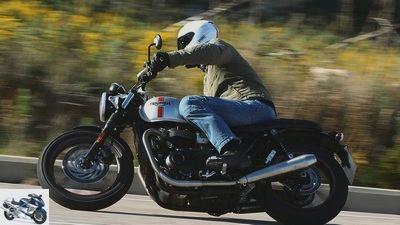
triumph
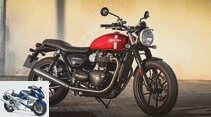
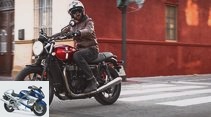
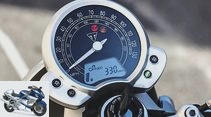
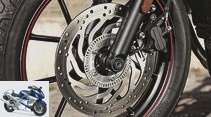
20th photos
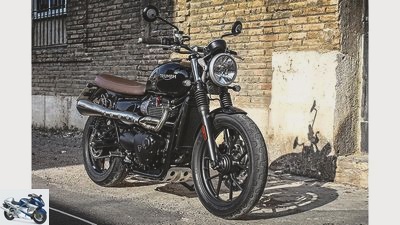
triumph
1/20
The scrambler conversion comes in a soft enduro look, but its chic exhaust is not approved.
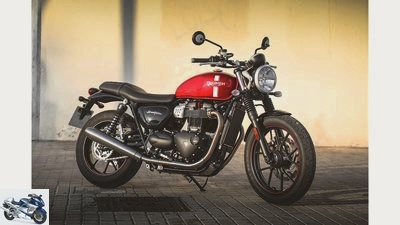
triumph
2/20
Triumph Street Twin.
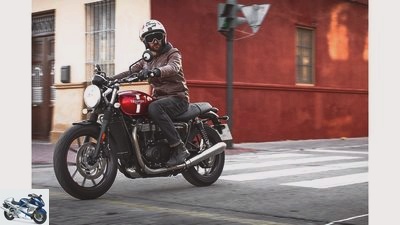
triumph
3/20
Triumph Street Twin.
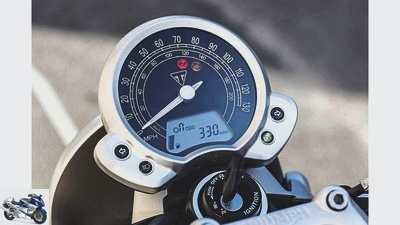
triumph
4/20
No tachometer, but information on the display that can be called up via the handlebar switch.
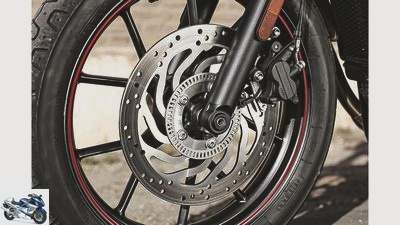
triumph
5/20
The single disc decelerates safely and ABS-monitored.
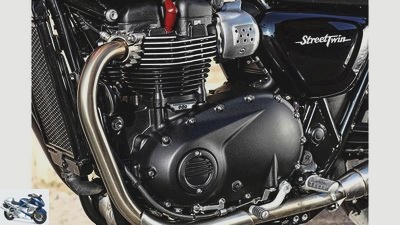
triumph
6/20
Additional rib cooling so that the water cooler can be small.
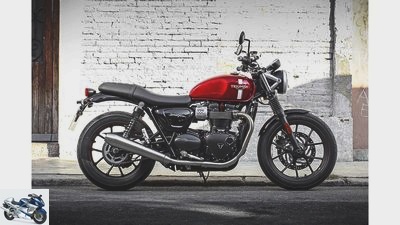
triumph
7/20
Classic lines – here in Cranberry Red – and lots of metal like the aluminum cover for the injection: the British know how retro works.
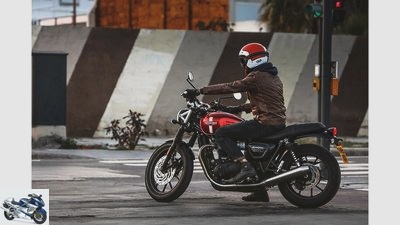
triumph
8/20
The Street Twin is available for 8900 euros (plus 450 euros for ancillary costs).
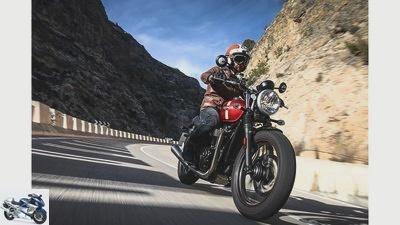
triumph
9/20
The Triumph Street Twin is available in red, silver, matt black or black metallic for an extra charge of 150 euros.
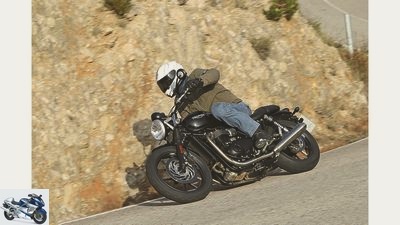
triumph
10/20
Plain black, called jet black, is the cheapest color option.
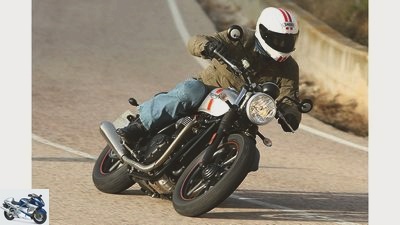
triumph
11/20
The Street Twin is agile without being nervous.
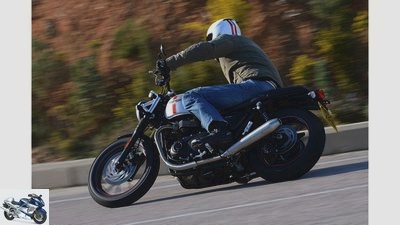
triumph
12/20
Triumph Street Twin.
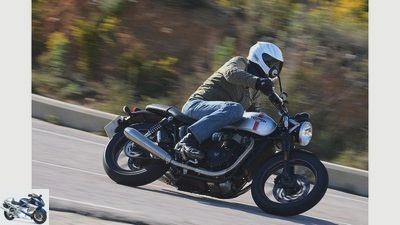
triumph
13/20
Triumph Street Twin.
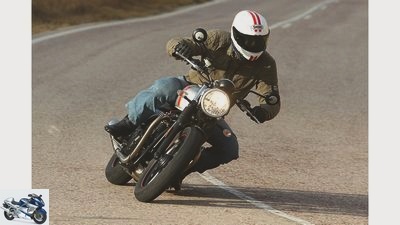
triumph
14/20
Triumph Street Twin.
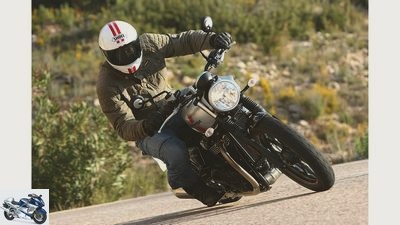
triumph
15/20
Triumph Street Twin.

triumph
16/20
Triumph Street Twin.
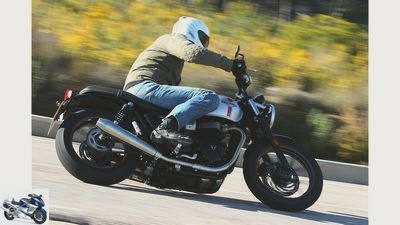
triumph
17/20
Triumph Street Twin.
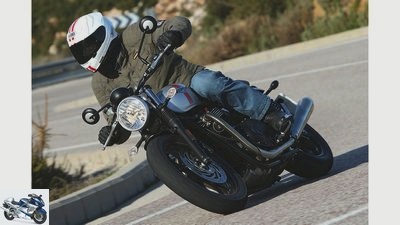
triumph
18/20
Triumph Street Twin.
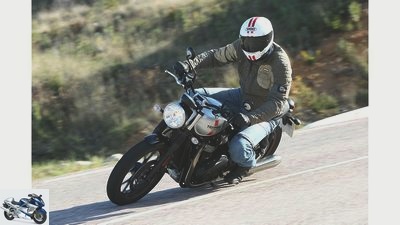
triumph
19/20
Triumph Street Twin.
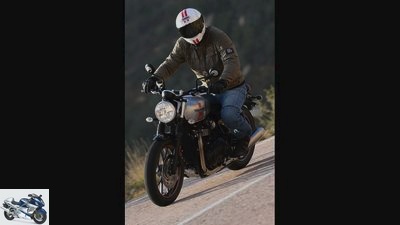
triumph
20/20
Triumph Street Twin.
Triumph Street Twin in the driving report
First Bonneville with water cooling
In 1959 the first Triumph Bonneville was available for purchase. Nothing has changed in their air-cooled engine concept over the years. Now the modern age is arriving, water cooling and electronics are coming on board the new Triumph Street Twin.
The year 1956, the air in the Utah salt flats flickers, a 650cc Triumph races by, reaching 345 km / h. A record. So there was a lot of power slumbering in the air-cooled England twin. When the bikes named after the successes in Bonneville went into production in 1959, almost 50 horsepower remained. And now? Part of the Triumph 2016 Bonneville family S.treet Twin works with a 900 twin-cylinder with 270 degree crank pin offset, water cooling, ride-by-wire and much more. Only when it comes to performance is the premium to the ancestor held back. 55 hp reports triumph.
Buy complete article
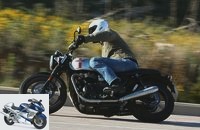
Triumph Street Twin in the driving report
First Bonneville with water cooling
Curvy roads around Valencia are waiting
On paper, the 900 engine should mobilize 80 Nm at a low 3200 revolutions. Scrambler and Bonneville are below that with 68 to 69 Newton meters, while in the middle of the last century the first variant was only 51 Nm. So enough of the preamble, the winding roads around Valencia are waiting. The Triumph Street Twin bubbles out of its stainless steel exhaust system while standing. It looks like a chic two-in-two solution, but behind the manifold covers it hides the exhaust gas cleaning factory that connects both sides in accordance with the Euro 4 standard.
The now thicker padded bench welcomes the driver at a height of just 750 millimeters. Good for those with short legs. But even long pilots can cope with it, because knees and feet don’t bump anywhere, and the seat cushion leaves plenty of space to slide around despite the slight edge. The clutch actuation, which even has a slipper function, works with just one finger. Nevertheless: When starting off, the twin needs a little more gas because the clutch jerks slightly, making it difficult to control. With the following jumps in the transmission, everything goes smoothly. Even with the constant intermediate sprints from traffic light to traffic light, the engine of the Triumph Street Twin puts you in a good mood. It looks livelier and has a lot more character than the very uniformly acting, air-cooled Bonnie drive and turns up to medium speeds more lively than the scrambler motor.
Developers attach great importance to the balance of the chassis
The city is behind us. The Triumph guides have put together a formidable lap in Valencia’s hinterland for cornering. Bend is lined up with bend. And the Triumph Street Twin naturally sweeps through the Winkelwerk. One reason for this is the new balance of the chassis, which the Triumph developers attached great importance to. It starts with the sitting position. Compared to the air-cooled Bonneville, the pegs are further back, the handlebars further forward and a little lower. This ensures that the pilot is more actively integrated into the vehicle – without being uncomfortable.
In addition, the rear suspension travel increased by 20 to 120 millimeters. The Triumph Street Twin is agile without being nervous, hits the desired lines exactly. Only when accelerating out can it easily start pumping at the back. After the struts at the stern were pretensioned two more steps, there was calm. This remained even with bumps and negligence in road construction. The otherwise non-adjustable chassis finely filters out rough bumps, shines with comfort and a good level of damping.
triumph
The Triumph Street Twin is agile without being nervous.
The speed at the apex of the bend increases, the Triumph Street Twin does it. The footrests only come on late. The braking system also plays along without any problems when driving at an angle. As before, a single disc in the front wheel has to do most of the work when stopping, but the effect is okay.
When the pressure builds up, initially only the minimal free travel on the lever bothers, then the desired braking force can be dosed very linearly until the ABS from Continental intervenes. This ensures safety and short deceleration values in moments of shock. At country road speeds, the control intervals are fine, in city traffic the ABS of the Triumph Street Twin is a bit coarser.
Triumph Street Twin relies on five gears
With the increased speed on the country road, the engine has to work harder. In order for the propulsion to be correct, it should always be kept in the medium speed range. Turning it all the way to the limiter does not help, as the performance zenith of 55 hp is already at 5900 rpm. The remaining 1100 revolutions until the limiter intervenes convey more pleasure-free engagement than fun cheering for revs. In addition, the Triumph Street Twin, like the Scrambler and Bonneville, has so far relied on five gears.
In order to achieve the credible 172 km / h top speed, the fifth gear stage is designed to be rather long. On winding country roads, the twin would therefore prefer to be moved in gears two to four so that the speed does not drop too far. Because: Despite the torque-optimized set-up, the Triumph Street Twin, which weighs a good 220 kilograms with a full tank, is no pulling miracle. Acceleration in fifth gear from city speed is smooth, but not very dynamic.
More performance makes you confident
Which reaches the point where the index finger can be raised. Because: When pulling through as well as when swinging around corners, the desire for more power arises. Not because more horsepower is always better, but because more power also makes you confident. The Triumph Street Twin loses this sovereignty as soon as you move beyond the maximum torque and power.
And Triumph is largely to blame for this desire for more kilowatts in the combustion chamber, because the Triumph Street Twin works so casually. Because it can be chased through corners really easily and without underhandedness and acts better here than its air-cooled predecessors. And the standard traction control that can be switched off would also make more sense.
Inspection only every 16,000 kilometers
The workmanship of the Triumph Street Twin, which only has to be serviced every 16,000 kilometers, is impeccable. The small water cooler, which is almost hoseless, the oil inspection glass or the maintenance hatch in the engine: Everything is nicely integrated into the design, the add-on parts are impressive down to the last detail. Thanks to the range of accessories, these can be adapted to your own requirements.
At the same time, Triumph offers three “inspiration kits” (see "Accessories for the Triumph Street Twin"), which contain a number of accessory parts as a package. Only in terms of performance will there be no surcharge for the Street Twin, which costs from 8900 euros and is therefore slightly above the 2015 Bonneville. But there’s something else to come. The new Bonneville T 120 and Thruxton models, which are also water-cooled, are already in the starting blocks – perhaps with a little more salt lake speed spirit?
Technical data Triumph Street Twin
triumph
Classic lines – here in Cranberry Red – and lots of metal like the aluminum cover for the injection: the British know how retro works.
Accessories for the Triumph Street Twin
triumph
The scrambler conversion comes in a soft enduro look, but its chic exhaust is not approved.
The Triumph Street Twin is a smart thing without any additional accessories. However, since it is common practice in the retro scene to adapt one’s own vehicle to individual preferences, Triumph offers a range of accessories that includes more than 150 parts for the 900 twin. This ranges from benches, small windshields, exhaust systems and rear modifications to luggage solutions and other handlebars and indicators.
In addition, Triumph has put together three “inspiration kits” from the available parts, which should show the potential for transformation in the Triumph Street Twin. Package number one goes by the name Scrambler kit and includes, for example, a raised exhaust system (without approval, since no cat), a rear conversion and another seat. At the Brat tracker kit the silencers are also replaced, as well as the rear and the indicators. Kit number three is Urban titled and contains, among other silencers, a windshield, a luggage bag and an M handlebar.
Related articles
-
Triumph 27 pictures Triumph 1/27 Triumph has significantly redesigned the Street Twin. We could already drive it. The 10 HP more power are noticeable and …
-
Driving report Triumph Thruxton R and Triumph Bonneville T120
triumph 20th photos triumph 1/20 The Thruxton has become a fine, classy cafe racer. triumph 2/20 Triumph Thruxton R triumph 3/20 Anyone looking for…
-
Triumph Street Scrambler (2019) in the driving report
triumph 23 photos triumph 1/23 Triumph has significantly redesigned its 900cc twin-cylinder Street Scrambler for 2019: stronger engine, better fork,…
-
Triumph Bonneville Bobber in the driving report
triumph 16 photos triumph 1/16 The first test drive with the new Triumph Bonneville Bobber. triumph 2/16 Unfortunately, the weather didn’t play along on…
-
Triumph Street Twin and Triumph Bonneville T100 in comparison
26 pictures 1/26 Power on the crankshaft. Measurements on the Dynojet roller test stand 250, corrected according to 95/1 / EG, maximum possible …
-
Driving report Triumph Thunderbird with Big-Bore-Kit
triumph 11 photos triumph 1/11 Triumph Thunderbird triumph 2/11 Triumph Thunderbird triumph 3/11 Triumph Thunderbird triumph 4/11 Triumph Thunderbird…
-
Driving report Triumph Daytona 600
Driving report Triumph Daytona 600 No more fun No more half measures. Triumph remembers its roots, is committed to sport and wants to cause a sensation…
-
Driving report: LSL-Triumph Street Triple TL-675 Warbird
fact Driving report: LSL triumph The LSL-Triumph Street Triple TL-675 Warbird This conversion of the Triumph Street Triple makes motorcycling seem like…
-
Driving report Triumph Bonneville America
Driving report Triumph Bonneville America Light show Low-calorie cola, beer with reduced alcohol content and yogurt without fat, America has shown the…
-
Driving report Triumph Street Scrambler
triumph 31 photos triumph 1/31 Triumph Street Scrambler triumph 2/31 The cockpit of the Street Scrambler comes from the Street Twin. triumph 3/31 Modern…